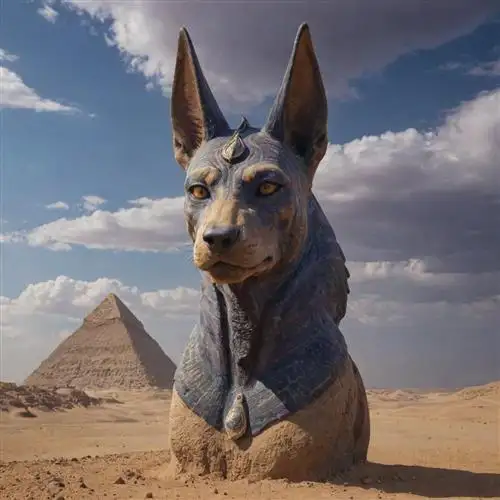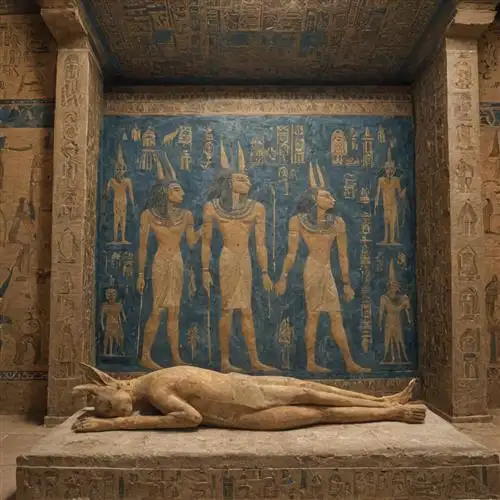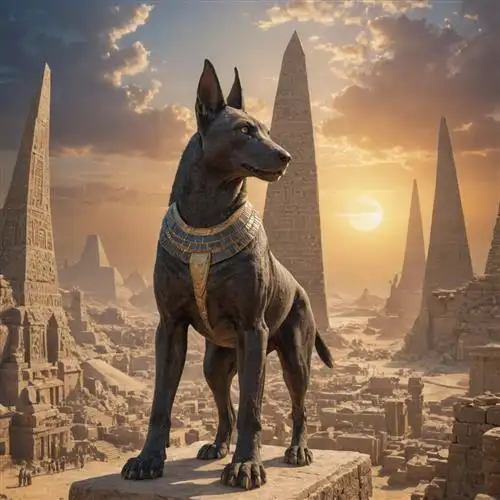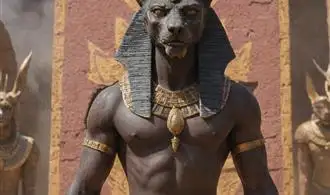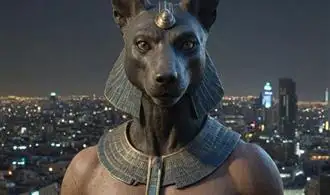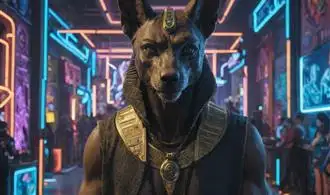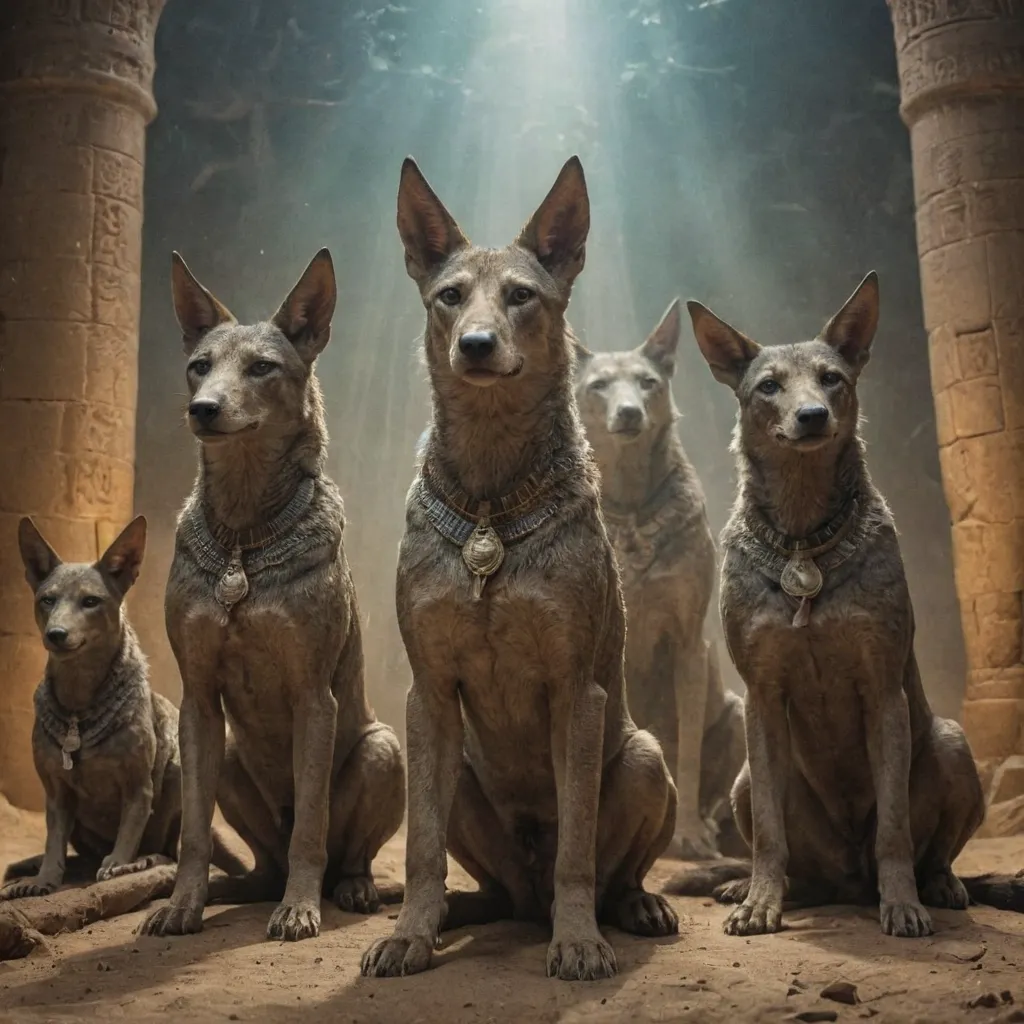
The Iconic Anubis Head
Anubis, the ancient Egyptian god of the dead, is perhaps most recognizable by his iconic jackal or dog-like head. This distinct feature holds immense significance within the rich tapestry of Egyptian mythology and symbolism. To interpret the Anubis head like an expert, it is crucial to delve into the deeper meaning and cultural context behind this captivating image.
The Anubis head is often depicted with a long, pointed snout, large erect ears, and a striking black or dark-colored appearance. This canine-like visage was intentionally chosen to represent Anubis's role as the guardian of the dead and the embalming process. Jackals and other canines were observed to frequent ancient Egyptian necropolises, scavenging the remains of the deceased. This association with death and the afterlife made the jackal-headed form an apt representation of Anubis, the god who presided over the crucial task of mummification.
Beyond the practical significance, the Anubis head also carries profound symbolic meaning. The black color of the head is believed to signify the color of the fertile soil along the Nile River, which was essential for sustaining life in ancient Egypt. This connection to the land of the living and the cycle of death and rebirth is a central theme in the worship of Anubis. The pointed snout and erect ears, in turn, represent the keen senses and instincts of the jackal, alluding to Anubis's role as a guide and protector of the dead on their journey to the afterlife.
Anubis Statues and Their Symbolic Significance
Anubis, the jackal-headed Egyptian deity, is a figure of profound significance in ancient Egyptian mythology. His presence is often marked by the striking depiction of his form in statues and figurines, each imbued with layers of symbolic meaning. Understanding the symbolism behind Anubis statues can offer invaluable insights into the beliefs and practices of the ancient Egyptians.
One of the most prominent symbolic associations of Anubis is his role as the god of the dead and the afterlife. Statues of Anubis were often placed in tombs and funerary contexts, serving as guardians and guides for the deceased on their journey to the afterlife. The jackal-like head of Anubis was believed to represent his keen sense of smell, which allowed him to locate and identify the dead, a critical function in the complex rituals of ancient Egyptian funerary practices.
The pose and positioning of Anubis statues also hold deep symbolic significance. Statues depicting Anubis in a standing position, with his arms at his sides, often symbolize his role as a protector and guide, ensuring the safe passage of the deceased into the afterlife. Alternatively, Anubis statues portrayed in a seated position, with his arms resting on his lap, can signify his role as a judge, evaluating the worthiness of the deceased and their deeds during life.
The materials used in the creation of Anubis statues further contribute to their symbolic meaning. Bronze Anubis statues, for instance, were believed to possess a inherent connection to the divine, as the color and luster of bronze were associated with the sun god Ra. Conversely, stone Anubis statues, such as those carved from granite or diorite, were often viewed as representing the enduring, timeless nature of the afterlife and the divine.
The placement and setting of Anubis statues within ancient Egyptian tombs and temples also held significant symbolic value. Statues positioned at the entrance of a tomb, for example, were believed to ward off evil spirits and ensure the safe passage of the deceased into the afterlife. Anubis statues found within the inner sanctum of temples were often seen as embodying the direct connection between the mortal world and the divine realm, facilitating communication and veneration of the god.
Interpreting Anubis Funerary Iconography
Anubis, the ancient Egyptian jackal-headed god, is a central figure in the funerary rituals and iconography of the pharaonic civilization. His presence in these contexts provides invaluable insights into the beliefs and practices surrounding death, the afterlife, and the transition of the deceased into the next realm. By understanding the symbolic significance of Anubis and his associated funerary imagery, one can gain a deeper appreciation for the profound spiritual and cultural significance of this deity in ancient Egyptian society.
One of the most prominent Anubis symbols found in funerary contexts is the jackal or canine figure. This representation reflects Anubis' role as the god of embalming and the protector of the dead. Jackals were naturally drawn to cemeteries and burial sites, leading the ancient Egyptians to associate these animals with the realm of the dead. Anubis' jackal form symbolizes his guardianship over the deceased, ensuring their safe passage to the afterlife.
Another important Anubis symbol is the embalming table or shrine. Anubis was believed to oversee the mummification process, ensuring the proper preparation of the deceased for their journey to the afterlife. The embalming table, often depicted with Anubis standing beside it, represents the sacred rituals and techniques employed to preserve the body and prepare the soul for its transition.
Funerary stelae, or carved stone monuments, frequently feature Anubis in various poses. One common depiction shows Anubis standing guard over the deceased, often with the deceased individual's name and titles inscribed on the stela. This symbolizes Anubis' role as the protector of the dead, ensuring their identity and memory are preserved for eternity.
Anubis also appears in the iconography of the weighing of the heart ceremony, a pivotal moment in the ancient Egyptian afterlife journey. In this ritual, the heart of the deceased is weighed against the feather of truth, with Anubis overseeing the proceedings. This symbolizes the judgment of the individual's actions and beliefs, determining their worthiness to proceed to the next life.
Additionally, Anubis is often depicted in funerary contexts alongside other deities, such as Osiris, the god of the afterlife, or Isis, the goddess of magic and healing. These associations highlight Anubis' role as a intermediary between the mortal and divine realms, facilitating the deceased's transition and integration into the afterlife.
Anubis Symbols in Egyptian Art and Architecture
Anubis, the jackal-headed Egyptian god, has left an indelible mark on the art and architecture of ancient Egypt. As a deity closely associated with the process of mummification and the afterlife, Anubis' symbols are deeply embedded within the country's rich cultural heritage. From the grand temples to the intricate funerary objects, the presence of Anubis is ubiquitous, serving as a testament to his significance in the Egyptian pantheon.
One of the most prominent Anubis symbols in Egyptian art is the jackal-headed figure, often depicted either standing or sitting, with the distinctive canine head and upright ears. This iconic representation can be found in a myriad of mediums, from stone carvings and wall reliefs to painting and sculptures. The jackal head is believed to be a symbolic reference to Anubis' role as the protector and guide of the dead, as the jackal was a common sight in the deserts surrounding ancient Egyptian burial sites.
Additionally, the ankh, the ancient Egyptian symbol of life, is frequently associated with Anubis. In many depictions, Anubis is shown holding the ankh, a gesture that symbolizes his power to bestow life and guide the deceased into the afterlife. This powerful symbol can be found adorning the walls of temples, tombs, and funerary objects, reinforcing Anubis' importance in the Egyptian belief system.
The Anubis emblem, a stylized representation of the jackal head, is another widely recognized symbol associated with the god. This simplified design, often composed of a circular or rectangular shape with the distinctive jackal ears, can be seen adorning a variety of architectural elements, such as doorways, columns, and wall panels. The ubiquity of this emblem underscores the pervasive influence of Anubis in the artistic and architectural landscape of ancient Egypt.
Furthermore, the presence of Anubis is particularly prominent in Egyptian funerary art and architecture. The god's association with mummification and the afterlife is reflected in his frequent depiction as a guardian of the deceased, often positioned at the entrance of tombs or sarcophagi. Statues and reliefs of Anubis can be found guarding the entrances to royal and noble tombs, symbolizing his role in ensuring the safe passage of the deceased into the afterlife.
Decoding the Symbolism of Anubis Jackal Figures
The Anubis jackal figure, a prominent icon in ancient Egyptian mythology, holds a wealth of profound symbolism that offers invaluable insights into the beliefs and customs of this captivating civilization. As the god of the dead, Anubis played a crucial role in the Egyptian afterlife, guiding the souls of the departed and overseeing the mummification process. The jackal-headed deity's distinctive appearance carries a multitude of symbolic meanings that shed light on the complexities of ancient Egyptian spirituality.
At the core of the Anubis jackal figure's symbolism is the jackal itself, a creature revered for its association with the dead and the underworld. Jackals were often observed scavenging in cemeteries, leading the ancient Egyptians to believe that they were closely connected to the realm of the deceased. The jackal's keen senses and ability to navigate the darkness of the night further cemented its role as a guardian and guide for the souls of the dead.
The Anubis jackal figure's distinctive black coloration is another crucial element of its symbolic meaning. Black was considered the color of regeneration and rebirth in ancient Egyptian thought, reflecting the cyclical nature of life and death. The black jackal head of Anubis, therefore, symbolizes the deity's association with the process of mummification and the transformation of the deceased into the afterlife.
Additionally, the Anubis jackal figure's pose and positioning hold significant symbolic meaning. Anubis is often depicted kneeling or crouching, a posture that emphasizes his role as a servant and protector of the dead. The deity's outstretched arms, with hands holding the crook and flail – symbols of kingship and authority – further reinforce his role as a powerful and revered figure in the Egyptian pantheon.
The Anubis jackal figure's association with the embalming process is another crucial aspect of its symbolism. As the god responsible for overseeing the mummification of the deceased, Anubis ensured the preservation of the body and its transition into the afterlife. The jackal-headed deity's presence in the embalming chamber symbolized the importance of this process in the Egyptian belief system, as it was crucial for the soul's successful journey into the afterlife.
Furthermore, the Anubis jackal figure's connection to the weighing of the heart ceremony, a pivotal ritual in the Egyptian afterlife, is a testament to the deity's central role in the journey of the soul. In this ceremony, the heart of the deceased was weighed against the feather of truth, and Anubis, as the guardian of the scales, ensured the fairness and integrity of the judgment process.

